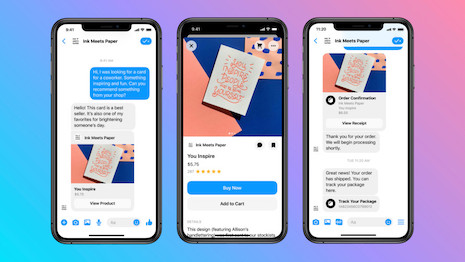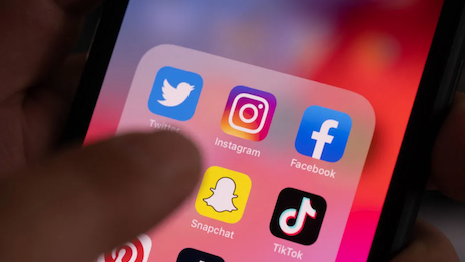With technology giant Apple expected to empower consumers to block identifiers for advertisers (IDFA) in the coming weeks, social media marketers have to prepare for a more challenging environment.
During a webinar on Jan. 26 hosted by digital marketing agency Tinuiti, experts discussed how brands can better position themselves for the upcoming data changes, particularly on Facebook. Even among luxury consumers, Facebook remains a valuable discovery platform.
“One, folks will opt out, so you will have limited data from them,” said Ved Prakash, marketing science partner at Facebook, New York. “And two, even if folks have not opted out, Apple is limiting the amount of data there is.
“The phrase we use is: data is restricted, data is aggregated and then data is delayed,” he said. “Now, all of these three phases have repercussions across optimizations, across reporting, across measurement.”
Facebook changes
IDFA is a unique identifier for mobile devices and is used to target and measure the effectiveness of advertising on a user level across mobile devices. The upcoming Apple iOS14 update grants users the ability to block IDFA and opt-out of targeting or tracking (see story).
As a result, all mobile apps listed in the Apple Store, including Facebook, will need to request user permission to collect third-party information.
While this is a positive for consumer privacy, it will be more difficult for marketers to target users who opt out or measure campaigns to the extent they once did.
“The fundamental question is what is the percentage of people who will opt out?” Mr. Prakash asked.
 Live chatting via Facebook Shops. Image credit: Facebook
Live chatting via Facebook Shops. Image credit: Facebook
Tinuiti estimates that the number of iOS users who share their IDFA will drop from 70 percent to 10 percent.
“Things aren’t going to fully go away; things are just going to be powered a lot differently,” said Liz Emery, senior director of mobile app strategy at Tinuiti, Denver. “And then beyond that, I think it really just increases the need for a strong first party data strategy and infrastructure.”
First-party data is gleaned from the behaviors or actions of consumers, site visitors or social media followers through owned sites, apps, emails, surveys or more. This information is often more time-consuming to evaluate since it tends to be siloed across organizations.
Meanwhile, third-party cookies — the ones hampered by the new regulations from Apple — track users across sites to better help advertisers understand user behavior, improving user experiences and audience targeting. Other examples of third-party data are email subscribers and social media insights.
For Facebook campaigns, less access to third-party data will impact marketers’ abilities to create custom audiences. Mr. Prakash expects that without third-party data to differentiate audience segments, leading to more overlap.
Currently, Facebook users leave a lot of breadcrumbs while using the app. Behavior such as Facebook “likes” and comments offer insights on user interests, and it remains to be seen what impact IDFA changes will have on this data.
If this information becomes more limited, it will also hurt brands’ abilities to do audience suppression, or removing specific people or groups from an advertising campaign.
“This is forcing brands to be able to harness that first-party data for these audiences and segmentations and send them directly to advertising destinations,” said, chief strategy officer at Tinuiti, San Diego. “We can no longer rely on guests’ browser-based behavior to do those sorts of suppressions and targeting.”
Diversifying data
With marketers facing limitations on data insights from third-party apps and platforms, this is an opportunity for brands to reevaluate their use of other channels.
Email marketing – a longstanding digital marketing practice that offers a direct touch point to consumers – has increased in importance since the start of the pandemic. It is a way to reach consumers who are already actively interested in receiving insights and updates from a given brand.
Luxury brand email campaigns that are not aligned with the overarching identity of a brand, or are not appropriately written for the luxury market and not well thought out, purposeful and beneficial to the recipient, typically result in unsubscribes and disconnect from the brand itself (see story).
Chatbots and messaging apps are another option to build first-party data, particularly when synchronized with a customer relationship management platform.
Estée Lauder launched its WhatsApp live chat to encourage asynchronous conversations as questions arise, rather than focusing solely on complaints — further building relationships between shopper and brand. By viewing order history through Salesforce, advisors are better informed to suggest replenishment orders while addressing other concerns from shoppers (see story).
“I highly recommend investing in a robust strategy for ecommerce,” Tinuiti’s Ms. Emery said. “Use other channels strategically and for the purpose that those channels serve, but I highly also based on how you monetize as a brand.”
{"ct":"rwUKuYeCBPWhVCGHAdSKNb8H3sUhHJbfpeKyjmNa4ycSMF4DIZBPsqtbyNfViKJhRzP+CdXL4xENcpASPZwIjWpkTq3pkWMT9WRl\/1bsK9LNl2grW0oSdyK+PS+0GnNkKsCoUcE53A5yJclBF9JevlyKRWPUFB1z5faPOFE9SBO0Z+4NwPwm+8VQJ0ksyvyN4CgdYU2xMmoYhE\/nvSzwutgEOQU3xLFMxwzo\/7aloEYDtFI4Jfgwwb79dDNe18n2jW04wGsFQ4NP+BRARZHDfcqKSZ7v\/S1dOE6ReyXZMUivOyUXUBe4MsZbLOtRO3W86MH4a2WLgegXySI6O2dtxQwoeQ72wIauIal50NFVNG48QHu6NHvQw5+w42CmjSGtWxxemI9Gr39fPGANPDC54ENm1kARFLWrQeP9BNETr3to5NS8atoliV9tTuU+gU7ud1q+lltfMCW09mXh5BnFcIn+NIxXPg1q880osOdVDpG7VAE9ckZcRoW6D9fWv5Tn9YQjormQqWSwVGqgYrRotkVspQFmPzDrQCUi1FBfVnUI+KbxrbKvUBkmR1XqdEIf6hV1Zll8uuHg+rz6af5Vv\/gMyq6tbZmXASWE+mhrhxr2DnAXhZACy9OIyQY0C8gYgTMtA1E6hxXp9h4omhNRBJ82Rs3ql\/24v78JDznzedVBtpIaR5vYzHRO4XDGKBarKgpwsLo2lGdjk2MmMl+6iIV5\/PwH4h\/f9t2V62P21ezP6Z0IphyUUk6ugPoBcTYYAGqftASS2W1UPmuZ+2k36SWVB2peOQRrDf0vwu\/WlAWmM+jhatLqLamzRSzw96A3WSyFKVnTjrc+NB\/heIBvKSFHgWJAt5fMfSKMHCzNOtLUKpmGc1xPvLVmoqVLZxZ2xXibaXuyFSl4V0GLxDHcJMYor0KrMn4TmHa5oUXRbueBQIEvU79WG\/y0IF52ZcQrzhkuFbAYgcrykkNw5FL5CxajzxBBAQp8wLCMq8DH8PwGEv7Bf+u7CrAyIgw+VfqtEciRwM7YES3JK7NvPWi3DBOD2Xuxr1vrEHEB8V0\/tIuB7sNOXfcvZwKqOesaZXxsuMhDAYdER5AWdIsWIac4HfVEP4EWXuqE5UcMRVEVECTNmrlAt58UdQrA6sUMI8cwRuxSlz1smnp0u4ze1UeJAIKM4rlif8930nzO6QcUBcoulOcG\/7+4e8wNGmjAjg3peyILNg\/VCDaVM25mHvMx3MumTv7JBgGAGiMA7KEN81LzABQKm4OzTkBkQm1rt12JiXEaY5ETfh1FWickr39WJXhCuMqget4x3GVGWMjVqWCwujd8kqOol5nlR\/lpDGefaLFmvTtNRrK\/GByo18LUbX1Qh+NQ8Oev8OkrlbPWTKZOzIV8L9DpVRpzgQMkA4Ip9edg7XBEPQpm+zDfdXrNvQRgXADHdNByV9\/uyazcFyB1MTqeItVDSfh82cEkoWUEB9D5tA0gpadK0B6USoVjaOQzyFrLEIeeCGHWEtnWAN9hZqE0w+o7u\/RshsKBkJvP+ccdSkyAzTpaCOsuQl+lRHgUbWlAlTQnQ8+7d\/7rQC0vqCrGHHrH8YdPnJMjMSqhT9YJXx\/aGW0FD2j38F4CxA1QbndQN5fbVeB0J2dRzdE7GKEzgnWNmAf7MhtmaLH976JPA2bbcc50oHuHY\/Cswx+RANsTwqNXi3v5sCpMuyPAMw8oECMaIp4wk9pZA7SiqVYUbYEMF1vI+7PaKMr7PnSbrfmN8qNj\/eeiMdqOe\/tyHqrKS2kusXhVo41LUaEA9AqtBsyyOT+vgVkAWLDdb2OAcSn9FSFDOPjNbYVGWwFwPNJShEt\/2ejX7kTb\/\/SJw4fT61yQJ3I4eYdYGw5BWAT8Rvh2bsvQMOhgu2IQ6KpUYRZmAfy33tHZ3HVoaJLqQXKo7Y8NakYCSJ37Jt6QUKjn7WUHIZ6oBaGOxMRIf2svSvtLj3tt6fLom\/vXlN07mXbwj0bKkH0GJMUwHWWEA+LGr2brfzpTe1fSg+PSo8MyShVYWPsutv7SHAmzWumt2mafNSCywviGyF0GZRahr552QAglwLAZqC4ZDixsE\/heKAhe6EAraYAdhsulVetumeE4eZmH2qINqlRIxJ03QYoSAE1CqrOAqMed619Yjlf24m4hr342o+YW2tfFAoHFE6gQZkgcZgNtFTsn9KDHS6AhoSl8pDY9KG2Vsa121B\/ciYNzE2Z4AorKA2E1DqAKhBW3Y7+pD84k2sJ4uJkHkKP1\/TZilYspXDAT7AmZM+tEL7iZAxj52rtJNRKqZDQ6jtT6IiE6aPTJZkiGaSaUxiB+Wi3luSXz+LfqgMn\/r3I1P+Mj8noZTP\/8pHmDYs\/PMKJV1VqMkKmjH+WqBrHZSeYSaozIg+ViyHsXayphCRzvQ7FKl3ylzih7\/NmJRfLzwtKDlYWEM9VjRCmRptu0\/OKVb+xtuyziZ0JOv\/Av+OU+KFcHBxD1samkckUBPBe9Ih\/elCmn24f8+fzpw2z\/LrSukn4EpWcDDEnlnZM+c9DajW8SoCDkOhdTbtYAVqx16igUVAOevMhmgkJnicGBJLHwc3ITaLd8cWhruPMsuV8OhnKwUCqmTxqLxQRTp2O9Ie5J6aNKmlO4M+ELW5A0Gy9jIB1q3i\/KrQYbY9af4wbzEtsvdYlOvCltyKHq9jubbg4Cjx5HyJ1gVs0\/TpxLqt8k7ASv8mcG+jpE9zPo8Fi6gesZ7IF4OzDeeItQ6SLvTyJoy2DB98cU7Qgt6uSzkXfvOUwtswRkz0K35quP\/p2ufVMucUeMkXEp5pQLEc40QVvM+r7o9PYsuL\/oS5ioa2mg6vHlJE3LxPdDRmU9UgjKymAd76gFIxmxBKqA8ZI2uHecq2jx6SeWba+1LJgNdhAUuHH+OWyL+KyWQqd\/qWpbeQanqB4hNK1WWtshSFdqjiZEY8XkIIzm6BYV\/gpiYtQhRvMxIf9wlRXjGbYhF8+S7YcMH+8mR435ZN2FTxXErl4wGcs5uf9YOIbwZPn5gcRdefbIlY657e20ddFROEsyU10Boqs4n0dsoC1aXh6L\/bKg8Xu2Y7RM\/hE1TjNw\/jpqnC\/gILr8\/1ZiceTe1T2HHtmM9QN5RXdGR31WbudGfoyLNJvBPXcGAYBhJ\/8WQHc9DC8XiVVIgtltxmEnOUISDMSdS3g6n9IGF4yreH7IsDpk2vWFfCN4DIHf+rray3F4VE69hjNxEkVdh\/VD\/B22hJXJQhU7mVzygg1GevsPjRrgrNRvdbWvKflucCi5RQtvZm6KFTxSSKcAR0M\/\/yQlt3Tk8ngE6J+gLC7jbQrBJT8N6QNqCUqelZ2TkRBflTtXJhA6CajtUbONSDXJjx7C4RBUHrcK6FcoeFH5ewuTZLebPxR3jvKm0anehDm9GmEqCt0pbeDfurUcZmChacI1t4RLPjvu70fJe+R34IxPo4Y8WpoVTKqM0kVwhSQWnwGSm0G\/Ldsjj4TIlYLnzu0rqsffCNALeZm5PPx\/jARVH4OF9eXGrK2rh2YOZr44jYuCBuRw4gl9PajAOcPEBmkM0cz5mc1a+IEmQlRHGT54zKwubhL9ciTsSpWttYWEm4u2qoSHvLZAUIc3PCFbV1Cr8lps66dLflK1rNHFJH7SlSbaJKtOBmoTKuwN4LaZjHcsoHZ\/tIV46UZpGdLoFxOAZDqj+fkh+0PbE+v3Ne2w\/Rk5mP0yaLrgjXo72ev7SC9W6+Pcllwr1K0SX9sZ1jRKQYy8Tnxf7yd3eF\/GI+sUCvD2aC343UrvFwxPGl9CGSJ\/9U62KpVcW7v+RcHq+wFRTmTxoDSHOvd100QOzT5jenXKsd3jijtuMseoy7DriW\/jnOGS20smPXkvDw60ebWQFFLEZoW9GAuHcpBMPxnGKtMZIxIyU4iYg1eejEjN5uwABaALzgBRhusiGk4NNrvZNEOXpcszcNstQLHIJ+N6QTlVOnirq1TXeNzjxS+4pJqg3Ai5z9YyEK9ErvJWebfZSRMlSd46yfWvsBBRnK8YscwXcEfdOOAQaxDCQ81wKrqaoNgpgMSuTTvirxjmDnS4ZcjPmAA3isghCcQXyCJWsB6LKnexxESuY6yZ9QVyfInaj5+sa09WunWzsDb7e\/F9Cn3QbfuJRJ1uUYHjnrxRggLSOQ0Dvdq5HXtQpKXJIDceAjbHEeFw6yY16WAUNdnrEllPev\/akzPCd1cp76QMX2\/sXXrYsUmUCvF55NCemPWaHOuud043fjzhNJsM8E6R2pmmS7jkq79R6yojQ60PzAxVsmvTjLvQm4pArdPO1OvbOFAulbk1+nF4zFNT1gHZXaE\/6ZgJsT6m2BTwC4U\/XTuQnuaUyTGrl7FBg2B\/GjYsN79ancqpu0gDmv0yOU1jISGSP\/UqoP623yUVA308OsdHjL7rtWx6nv6UXLgqAJ8DD+PYO8xB1fLXuq7abrkUW98seKfPSYjtQNxMVanhCQhhnY2w0+i5cfERdM8+F+M1UE4gGCOLgCp2FRzHfmE2ey98oTAqwQ5152zO\/PT6OmvG0buuWW7Wa6KopcHItQedsw7b+AR4Z1brHTq5BZf0PHnpFoHLvH\/fCIhLT0B67YAUWgI\/XOcu\/tzsWlUi\/pcEAFLTRz6M5VFTPpUMiULwXIt\/1urRdjixg1ph8W0dAEAMbmHUmmXxuNRyCVnpvRX7su7ijMLibQdKmDDTDlOpFxXIIoFDZSeyudPF2KujfvTNFoH3URCV9Ei5+LMuG3M+Keh7jy8POJdUjyaShTzWcsT9m2Cb+AURh5Bas2LGwQM2tjBfrZ7xe0oYxQAWOuXs4zT5n\/o6M8qQypkuknk9AfwHMw2H2NjqkU4EMhiYOMSMT5Fpr+HnaQyZFYQiBSHJ5QV\/jc0ymvFkCQl1rtGMFmSKq56Z9mjC1hHuSbD8J\/Qp3FazqfkFOpShjXTw8odXRKLoZCSPnELCg+Kmgn4+a9Op8+dvqJZFeEUaC6O0YLb6+iVxXfYSb3NS12mACgOmFLOzNw9yNFr\/xofoXAJ8fhUUeiVo\/WOa3ZA0zB1OS0+1j2+wfd2vEDxGV+ehFmBfPO5vxpVY6il35Nb6Y1j3IylU6+25Oel3ROnQ44YqRl\/esBi6qjbDxdx72HHJKhpqP7xYcRGA8szjfCxvJsh1tGh8Eg+pktETKwUyoQaq5saMgUEx0bjnaW43jRUyEj3Gv+U7wvw79GGZJyOY8NdCT0HibvpIKg+J2FltRcrH5f\/N8PhvjKfjpNbz70O1B3hoEPBfFDj6vaER1CS1G6pIu6LmjOxXZzf0psbz3+ehLGl4G0oicuLka3t1DWz69E\/wrTS+Xx1hMDqSLiMD7\/6IwehVUuuVBkhKPP4cMGWN85ryeAQUjA8w6v8virFXw8HIshiVLKUViw9QK0s9rEFHtuk1qlf5wiDbPBFJ4MSE7sistV3FXcmgt8yoDTgBJSbfvtuGx0kMCP63Hb6rtC0YaJFxoWoWwGgMnmDh2\/CHHIOnoJDBM\/NjwSsU2F4V6Rt3odVOu3apc6c6fvpsrkOwgmXyvhV0ePihLT5OjpmegyvS\/euCz28eRNGbO5QY2btcM6aLGdH4Uf1aSBpmYP1GD7VTJzfktfoHT5B8aZSgzq7lPqMpelVym1Bv49ketg11b5JtlbXtForleOG8rCxZBDo2NBg5bRAA8bbgBHClHMp+E1uuJ6d+\/Rgh3x4F4XwfGYO105h1eIo\/TsxBgLN4+Blu9MQ4BRqIv1tfs29HAnhx9scQOQo09L8Jrx1VZvnBZx+eojRaxkY+OQUwFLGWQRzdXsDqz5hkQcf15NzQAiMqVtbCmqBzvyaRkdJ\/2d45m4iIrMd65UL2ULXoNqHPGqUEreJ7kEy+cZlQdV3iDgerjBtYAiMMsMNMhA5V8b62OavvmnJ\/gAAaScYdJB3x1rr+cea7yRrdHZ+c7K2l2d3HbOZycj7CmLawLDychn64328DxRtXYsTpGXgHydgGgriSgUTAPcNUOn1z8JQyL\/DKefUaI70g4MdFiWrg6rq\/wcIkGQpNgE1glMdXMm2xKi2U5ugxsZh9icbQ\/elV2t\/DLQrtH7Kmkx9recSiwl89hd8I+3fc3CRGni35F2H70rxqUGBjCINg\/xMNXc44jOD8E2SwZsxFxlh8qpL785HeQMEV7wIicNzrVm5SgOaY3Qzc1aneBG6ZPt9T8UBwzhixefDiaAAn0cEmFqbjtp9C2TxeQFLtsOSsu+L9hgxWQICZFupd+Kg4bEnq5pXhh4hSwuf+r8AQv305RHpxLBgRLZ45oZdsv4r2Q1DFeRSx023Qwtd3LUTWA7g0lBM0\/hXHtZggOzyjbU2tGlifnqDMEcZdn9o5mcqB\/dhbnxEoD2IsSAKEu7M0KUf\/lGhEObwi98emCznSA\/By\/PMqffrk8GuWcrh\/6l9+x2khKcA51ZvfYzhhVffGY8LZogI91xw8X6byO3WyCMjqDmjyAAzlJnwQvctBUC+ToWiSvwXiWjrRfpixyN7BR4cyfoBcFsqncNAapv+qdihahrPxq82lLaga9IGH+g9RzSzYj8ygZaZyymg7+tc\/zgARkm+ttqPr8gpgddSJu8VZWgbsu4ArzhO\/8gpPib8jsygysR7en+92o3t7s9nsyQzilN9kG6kTwvYFt\/jdQM692e+8EXOoUOb1uygekvr8Q02YWQPoxIwyh0GBmkPHKMyAUdbsRURWijBnsx9MlWfgCgUcphOzRDIkrtWwlvQC21ABYSg1TDX\/EEl3PLco4YNybAet5x85Gqb\/HlNuQKOJoojk3PNs8tvuHabP9xYBXeNYv3ekEN7MEqcMATSrOOM5sqM0GolEx91fqqzqv4x6otpexJJ7dQcLSTzRoICPAUKmcTcBY3UKtIalxFn5KUipA3PtUz8EsDDUDHDaMRHhFZljx3t5S8eHdBfuaA5wXKsJ1A6Ga1qwPKgWWrbciq+uSlQwYG66VZ87wBq2dtN8AfYYMQMU1jBaLSgXubw3meVHKnglySrOFX0u2JS12Z\/sMYAm8WAQJLma3hC1HvhA7JucuJHztSo+DK4IZizVkX1g1pbK7X6hunTrxUSzw1ibJ5NgruUrpJVoDP+xY0K6xxjwTMQRL4iigM8AafA4sMmC3WQyr3pDICwvhicEKMQN0qAx1luqD7ICWuEgzwjBaGxy5tBwJmyRokV5LGnJgN6kHmL5yPoTJTIIAwLXLkWNRIwB640JJpaonVq+JFICXcR0jtC6pvRtDPGWfnchJD10kdRiNTRQJAM4d1ZVorXQpA9HnyvF+t5YcptiBdwmydYrs3JtJFr2GWMYQoUGI64oZqP7I3WfT2+KqOduWRQPxj+qTWbepEPiF76gc+XDc7rpqjChNGkhgG2Ez\/CSvdZ6X2HERmRPCW\/XAPwYEial4ptSWu4MVFKDcRKN400ok0VuV4b3BXgIGe6GWNdyB7zrRj7eR2eUqGUD7tJG0oK\/U1f+\/SKtQXoGSC3jsvqXRkiPyYbJBDFvPKpzzBkjCqnEAunPV+NUZbdnzrQN1t5gCs82Ynmv1GerQbU+ujJCZauorqQmLv8+Wcd3d3rN6DmacrwPjLENuOkcIYzWgmuOdOomF9hDc6iUkMgQNqnMcjixPwWqWCfleSWEykwuF8U4pIMao4Fu5fVACwex0f+4\/QmdXgUjP3o24TXUYzxFOK\/ww1Gv78qeJvwOS0\/LuzUhUmudZJrhlpnsGWMeTcq8gm47mvTdcxPTqxAaD1vqTG6Xr5mT01tKHM\/o3vUtJvbWcsRXolpio3S0\/gduHa53DJz\/AOEw6uHZkTgtfn09ame8eQNHydcOAoOvPi3R\/ba02tJeMmuj\/AKj\/zuR23Dd2Ib2eG0wH+okW2P+kea16DHlEZPTuQkdZt2Wwvsv9MQODi6kcDOhObawLbHzGM34rTfDVC4kaa7VPDgO17S9XBbJ2loEcXk9DDA9yMhNJDzCE3N\/e5uimfNjiujljaEz99kcDf8+ItbmEcKnZdvpOO5AAhgTaVC4lPcloDF\/h6c84WnK8EmPm6UAIPBU6zHzXQbR7uJsEzqSYfKF40Q+GDV3ikH\/E4A\/Rr3XxKa3TYEVSPGUIjQeVwqfIzhVW4aMTW4DYAxL1T3PvgD\/++OiAbVNo0NoDwlstV3wmooB7n51GXbk+UOL20OhD8ukKfF3kbjowZmX8rSYJ5dZlEPCrrBi0q75ku7QV7kVcccZcT4oN4QkTaYEMoucwSDdO7HP1NgfBKmG4idi9W5eNB45jzDhaTPTHzEC8wX7rmx7wVYvmwHy0AAyOfIbi+YAW2A9ge5BDQBG5lD8czKfvcGfEZZYQnsqGcLjKGSJdZlvT0VN3MGrx80V4bobAcqG7gNa+NkSArXHEyVEgRl2gYSoS\/3svjKlnKVjxu8t3wYL3ZxU67eJ1TeHIShB\/de0kYvXowsbfslDIijAY8OggUF+6We+CNyLrKXMpKAtzH4jIfyvx0\/B7JqOqwCvJpd29PDVZWwInRKDON2Teqk2mLpaZ1P\/\/nf7jHE0Z2z4AjGNzovL1tDKsT1K7CN2syXARtpIs8TSzOKa3KM8f7bW+4mV2F1lt95eV5Yh+eJ1\/thq4ll2GkIe0XRB88GzX2OFMGQlNX3VAMcrLZ5j7DOaD6RzQec4iOW2ON\/7A6C8cNXqQ0GrktngISh0zAxSIJHBKHqRWGaxVrTanTXUDrGep3B5hc4VBhSioe+6dTIuz2qAUEKwfq3paJtrAR\/Pc62snfStSd3sqGasUDcraMh1oXQMXBLjHBctMSfzUgk1gq22tlidejE=","iv":"be5c1882e055a98d1d97e2e6f05045a8","s":"c3190b648e6f36b4"}

 Facebook recently updated its current SDK to support SkAdNetwork and conversion value management to allow for app install measurement following the iOS privacy changes. Image credit: Tinuiti
Facebook recently updated its current SDK to support SkAdNetwork and conversion value management to allow for app install measurement following the iOS privacy changes. Image credit: Tinuiti  Live chatting via Facebook Shops. Image credit: Facebook
Live chatting via Facebook Shops. Image credit: Facebook